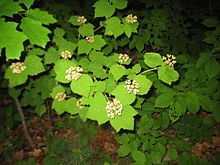Viburnum acerifolium
| Viburnum acerifolium | |
|---|---|
 | |
| Conservation status | |
| Scientific classification | |
| Kingdom: | Plantae |
| (unranked): | Angiosperms |
| (unranked): | Eudicots |
| (unranked): | Asterids |
| Order: | Dipsacales |
| Family: | Adoxaceae |
| Genus: | Viburnum |
| Species: | V. acerifolium |
| Binomial name | |
| Viburnum acerifolium L. | |
Viburnum acerifolium (Maple-leaf Viburnum or Dockmackie) is a species of Viburnum, native to eastern North America from southwestern Quebec and Ontario south to northern Florida and eastern Texas.
It is a shrub growing to 1-2 m tall. The leaves are in opposite pairs, 5-10 cm long and broad, three- to five-lobed, the lobes with a serrated margin. The flowers are white with five small petals, produced in terminal cymes 4-8 cm diameter. The fruit is a small red to purple drupe 4-8 mm long. It attracts butterflies and birds. The Viburnum acerifolium is a larval host to the Spring Azure butterfly.
The scientific and common names refer to the superficial similarity of the leaves to those of some maples (Acer); the plant is occasionally mistaken for young maples, but is readily distinguished by the flowers and fruit; the viburnum produces small, purple berries, while maples produce dry, winged seeds.
References
- ↑ "Viburnum acerifolium". NatureServe Explorer. NatureServe. Retrieved 2007-07-06.
- Germplasm Resources Information Network: Viburnum acerifolium
- USDA Plants Profile: Viburnum acerifolium
- Bioimages: Viburnum acerifolium
